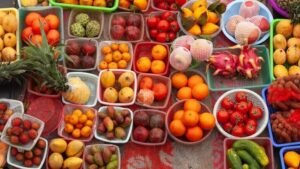The world has developed quite the sweet tooth. What started as an expensive luxury has transformed into one of our most widespread dietary staples. Today, sugar flows through global markets at unprecedented levels, reaching every corner of the planet and shaping eating habits across cultures and continents.
Yet the distribution of this sweet addiction varies dramatically from country to country. While health organizations sound alarms about overconsumption, certain nations continue to pile sugar into their daily diets at rates that would make your dentist weep. The patterns reveal fascinating insights about culture, economics, and our complicated relationship with sweetness.
The Global Sugar Landscape in 2025

The global consumption of sugar amounted to about 175-176 million metric tons in 2023/24, and is projected to increase to about 178.79 million metric tons by 2024/2025. These staggering numbers represent more than just statistics. They reflect changing lifestyles, urbanization, and the growing influence of processed foods worldwide.
With the increase in world trade, better agricultural technology, among other reasons, sugar is cheaper and more widely available than ever. This accessibility has fundamentally altered consumption patterns across the globe. What our grandparents considered a rare treat now flows freely through supermarket aisles and restaurant kitchens.
The geographic distribution of sugar consumption reveals stark contrasts. India consumes the most sugar of any country, followed by the European Union and China. However, when we examine per capita consumption, an entirely different picture emerges that challenges conventional assumptions about global eating habits.
Mexico Takes the Crown

Surprisingly, Mexico claims the dubious honor of highest per capita sugar consumption globally. Mexico had the highest sugar consumption per capita, with an average of around 135 grams of sugar per person per day. That translates to more than half a cup of sugar daily for every Mexican citizen, including infants and the elderly.
This astronomical intake stems largely from Mexico's beverage culture. Soft drinks flow like water in many regions, often more accessible and sometimes cheaper than clean drinking water. Traditional Mexican cuisine also incorporates substantial amounts of sugar through sweet breads, desserts, and beverages like horchata and agua fresca.
The health implications are profound. Mexico's sugar consumption correlates with rising rates of diabetes and obesity, creating a public health crisis that officials struggle to address through taxation and education campaigns.
United States: Sweet Obsession

America's love affair with sugar runs deep and wide. The United States is among the biggest consumers of sugar globally. According to sources, the country's per capita sugar consumption is 126.4 grams daily. This represents more than five times the World Health Organization's recommended maximum intake.
The culprit for this high sugar intake largely relates to the quality of food, with around 60% of the US diet consisting of processed foods on average. These processed foods typically contain more calories, fat, salt, and added sugars. Additionally, the United States leads in snacking, with snacks making up about a fourth of daily calorie intake and a third of added sugar intake, significantly contributing to the nation's high sugar consumption.
American sugar consumption reflects broader cultural patterns around convenience foods, super-sizing, and the ubiquity of high fructose corn syrup in manufactured products. From breakfast cereals to salad dressings, sugar hides in unexpected places throughout the American diet.
Germany's Sweet Traditions

German sugar consumption might surprise those familiar with the country's reputation for health consciousness. Germany is among the largest consumers of sugar globally. According to the Washington Post, an average German citizen would consume 102.9 grams of sugar daily.
With an average daily sugar intake of about 102.9 grams, Germany ranks as the second-highest sugar-consuming country. Much of this sugar intake comes from desserts, with nearly half of Germans regularly snacking on desserts and 60% reporting typically ordering desserts when they eat out in restaurants.
Germany's confectionery industry plays a significant role in this consumption pattern. The country produces world-renowned chocolates, pastries, and sweets that permeate daily life. Coffee culture also contributes, with elaborate cakes and pastries accompanying afternoon coffee traditions.
Netherlands: Hidden Sugar Champion

The Netherlands occupies third place in global per capita sugar consumption. Sources indicate that the per capita sugar consumption is 102.5 grams per day, doubling the WHO's recommended amount of 50 grams. This consumption level reflects broader European patterns of processed food integration into traditional diets.
According to the National Library of Medicine (NLM), the main foods accounting for the high sugar intake in the Netherlands include non-alcoholic beverages, cakes, cookies, candy, sweets, dairy, chocolates and other sweet foods. Dutch food culture embraces sweetness through both traditional treats and modern convenience foods.
The Netherlands demonstrates how even health-conscious societies can fall into sugar traps. The NLM further indicates that very few people adhere to the WHO guidelines on low sugar intake of less than 5% of total energy.
Ireland's Sugar Culture

Ireland rounds out the top sugar-consuming nations with distinctive consumption patterns. Ireland is the fourth largest consumer of sugar globally, with a per capita consumption rate of 96.7 grams per day. This level represents nearly four times the WHO's recommended maximum intake.
A vast percentage of this sugar is contained in processed foods like juices, sugary sports drinks, cookies, sweets, cakes, doughnuts, jellies, chocolates, ice creams, etc. Irish consumption reflects broader trends toward convenience foods and beverage culture that have transformed traditional eating patterns.
Though the Irish people are known for their uncontrolled craving for sweet things (sugar culture), some consume added sugar in seemingly healthy food out of ignorance. This highlights how hidden sugars in processed foods can drive consumption beyond conscious choices.
Brazil's Total Consumption Leadership

While Brazil doesn't top per capita rankings, it demonstrates significant sugar consumption patterns. Brazil had a significant sugar intake, with an average daily consumption of about 117 grams per person. As both a major sugar producer and consumer, Brazil represents an interesting case study in domestic market dynamics.
Brazil is one of the leading sugar-consuming countries, primarily due to its significant production of sugarcane. Brazilian consumption per capita is around 56 pounds (or 25.4 kilograms) of sugar annually. The country's position as the world's largest sugar producer creates a domestic market flooded with inexpensive sugar.
Brazilian consumption patterns reflect cultural preferences for sweet beverages, desserts, and the integration of sugar into traditional cuisine. The availability of cheap domestic sugar has embedded sweetness deeply into Brazilian food culture.
Argentina's Sweet Tooth

Argentina demonstrates substantial sugar consumption across South America. Argentina also had a high sugar intake, with an average daily consumption of around 116 grams per person. This places Argentina among the world's highest consuming nations, reflecting regional patterns across Latin America.
Argentine consumption mirrors broader South American trends toward sweetened beverages and desserts. The country's agricultural economy provides easy access to sugar, while cultural preferences for sweet mate preparations and pastries drive daily intake higher.
Like its neighbors, Argentina faces growing health challenges associated with high sugar consumption, including rising diabetes rates and obesity levels that parallel consumption patterns.
Australia's Surprising Position

Australia's sugar consumption levels challenge perceptions about health-conscious developed nations. According to the Australian Bureau of Statistics, the country's per capita sugar consumption rate is 60 grams per day. While lower than the top consuming countries, this still exceeds WHO recommendations significantly.
This translates to 14 teaspoons, exceeding the recommended level by WHO. Australian consumption patterns reflect the influence of processed foods and beverage culture that have transformed traditional diets.
Like other countries discussed above, a significant percentage of this sugar is consumed in foods and beverages like energy drinks, electrolytes, fruit and vegetable juices, cordial, cakes and muffins.
India's Massive Total Consumption

India leads the world in total sugar consumption, though per capita figures tell a different story. For the time considered, India had a total sugar consumption amounting to approximately 31 million metric tons. This massive figure reflects India's enormous population rather than individual overconsumption.
In 2023/2024, the overall domestic consumption volume of sugar was 30 million metric tons in India. The sugar consumption volume is gradually increasing since 2019/2020. India's consumption growth reflects economic development, urbanization, and changing dietary patterns.
In India, sugar consumption has been steadily rising. The per capita consumption of sugar in India is approximately 22 pounds (or 10 kilograms) per year. The country has a vast population, and sugar is an integral part of traditional Indian cuisine and sweets.
China's Growing Sweet Appetite

China represents one of the world's fastest-growing sugar markets. China has seen a dramatic increase in sugar consumption over the past few decades. With a population of over 1.4 billion people, China's per capita consumption is around 30 pounds (or 13.6 kilograms) of sugar per year.
China's sugar consumption growth reflects broader economic development and dietary westernization. Traditional Chinese cuisine used limited sweeteners, but modern processed foods and Western-style desserts have dramatically increased sugar intake across the population.
The scale of China's market means that even moderate per capita increases translate into massive total consumption growth. This trend represents one of the most significant developments in global sugar markets.
European Union's Collective Impact

The European Union collectively represents massive sugar consumption patterns. India consumes the most sugar of any country, followed by the European Union and China. As a trading bloc, the EU's combined consumption rivals individual nations despite varying patterns across member states.
European consumption patterns vary significantly between countries, with Northern European nations generally consuming more sugar than Mediterranean countries. Traditional food cultures influence these patterns, though processed food integration has increased consumption across all regions.
Larger sugar outputs are also seen in China and the European Union. The EU's position as both a major producer and consumer creates complex market dynamics that influence global sugar prices and availability.
Health Implications and Global Trends

The health consequences of global sugar overconsumption have reached crisis proportions. The World Health Organization (WHO) recommends a daily intake of less than 25 grams (5.75 tsp) of sugar per person for improved health. Yet most high-consuming countries exceed this recommendation by three to five times.
High sugar intake is linked to an increased risk of obesity and overweight, affecting over 650 million adults worldwide. Excessive sugar consumption is associated with a higher likelihood of developing type 2 diabetes, affecting approximately 422 million people globally. Consuming sugary beverages regularly increases the risk of heart disease by up to 20%. Dental caries (tooth decay) is the most prevalent diet-related disease, affecting almost half of the world's population, primarily due to high sugar intake.
Several countries have implemented sugar taxes to reduce sugar consumption and promote healthier diets. These policy interventions represent growing recognition that sugar overconsumption requires coordinated public health responses.
The Future of Global Sugar Consumption

Global sugar consumption continues its upward trajectory despite mounting health concerns. Over the next ten years, global sugar consumption is projected to expand by 1.2% p.a. and reach 202 Mt by 2034, driven by population and income growth. This growth will primarily occur in developing nations as disposable incomes rise and processed foods become more accessible.
An estimated 175-177 million metric tons of sugar will be consumed across the globe in 2025, a 15% increase from 2011. This growth pattern shows no signs of slowing despite increasing health awareness and policy interventions.
The challenge facing global health authorities involves balancing economic interests with public health concerns. Sugar production supports millions of jobs worldwide, while consumption patterns reflect deeply embedded cultural preferences that resist easy modification.
The global sugar landscape reveals troubling patterns of overconsumption that span continents and cultures. From Mexico's beverage-driven consumption to Germany's dessert traditions, the world has developed an insatiable appetite for sweetness that far exceeds nutritional needs. The health consequences are mounting, yet consumption continues rising globally. Perhaps the most sobering realization is how dramatically actual consumption exceeds health recommendations across virtually every high-consuming nation. What do you think about these consumption patterns? Are you surprised by which countries consume the most sugar?





Leave a Reply